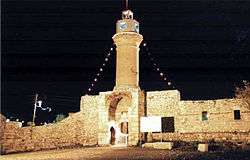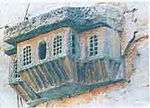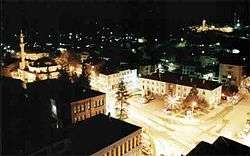Zile
| Zile | |
|---|---|
| District | |
|
Zile City Center at night | |
 Zile Location of Zile | |
| Coordinates: 40°18′N 35°53′E / 40.300°N 35.883°ECoordinates: 40°18′N 35°53′E / 40.300°N 35.883°E | |
| Country |
|
| Region | Black Sea |
| Province | Tokat |
| Government | |
| • Mayor | Lütfi Vidinel (AKP) |
| • Governor | Mehmet Eriş |
| Area[1] | |
| • District | 1,560.65 km2 (602.57 sq mi) |
| Elevation | 710 m (2,330 ft) |
| Population (2012)[2] | |
| • Urban | 34,442 |
| • District | 61,765 |
| • District density | 40/km2 (100/sq mi) |
| Time zone | EET (UTC+2) |
| • Summer (DST) | EEST (UTC+3) |
| Postal code | 60400 |
| Area code(s) | 0356 |
| Licence plate | 60 |
| Website | Official website |
Zile, anciently known as Zela, is a city and a district of Tokat Province, Turkey. Zile lies to the south of Amasya and the west of Tokat in north-central Turkey. The city has a long history, including being the site of the Battle of Zela, which prompted the phrase "Veni, vidi, vici."[3] Today the city is a center for agricultural marketing and tourism.
History

Historically, Zile has been known as Zela, Zelitis (Ζηλίτις in Ancient Greek), Zelid, Anzila, Gırgırıye (Karkariye), Zīleh, Zilleli, Zeyli, and Silas. Zile castle, the only solid castle in Anatolia, was built by Roman commander Lucius Cornelius Sulla. The castle contains the Amanos temple, and is called silla, meaning "respected". In Semra Meral's Her Yönüyle Zile, she claims that the name "Zile" came from "Zela", stemming from "Silla".[4]
According to recent archaeological research, there is evidence of human habitation since Neolithic times in Zile.[5] In his book Geographica, Strabo claimed that Zela was founded by Semiramis, a legendary Assyrian queen.[6] By 548 BC, Zela and greater Anatolia were under the rule of Achaemenid Persian Empire. Persian rule saw construction of a portion of the Royal Road in the area, and of temples to the Persian gods Anahita, Vohu-Mano, and Anadates in the city itself.[3] Darius I of Persia divided the largest Anatolian state of that time, Cappadocia, into two, with Zela remaining in Pontus Cappadocia, the northern region.
After roughly 200 years of Persian rule, Alexander the Great captured Zela from Darius III of Persia as a result of the Battle of the Granicus (334 BC). Following Alexander's death in 323 BC and the collapse of his empire, Zela passed to the Seleucid Empire, a Hellenistic successor state of Alexander the Great's dominion. It controlled the area for 200 years, but by 100 BC, its power in the region started to collapse. As a consequence, King Mithridates VI of Pontus attacked and took Zela in 88 BC, and ordered the killing of all Romans living there. This led the nearby Cappadocians to call on Rome for help. The Roman army, under Sulla's command, fought and defeated Mithradates in the First Mithridatic War. Mithridates attacked Zela again in 67 BC with the help of his Armenian ally Tigranes the Great, king of Greater Armenia, initiating the Third Mithridatic War,[7] which ended with victory by the Romans under Pompeius Magnus and the suicide of Mithridates in 63 BC. In Pompey's settlement of Pontus, Zela received a civic constitution and a sizable territory thus transforming from its previous status as a temple domain to a city.[8]
In 49 BC, civil war broke out between Julius Caesar and Pompey. While the Romans were distracted by this, Pharnaces II of Pontus, son of Mithridates, decided to seize the opportunity and take revenge for his father. His attack on Zela was halted by Julius Caesar in the bloody Battle of Zela (47 BC).[9] While Caesar's army suffered great losses, Pharnaces's was completely destroyed in five hours. After this victory, Caesar sent his famous message to the Roman Senate: "Veni Vidi Vici", meaning "I came, I saw, I conquered".[3] Caesar's words were written on a cylindrical marble column and placed in the city castle.[10]
In 241, the Sassanid king Shapur I, attacked the Romans and defeated Roman Emperor Valerian, thus capturing Zela. From 241 to 1071, Zile was conquered many times by the Byzantines and Sasanids. Under Byzantine rule, Zile became a Titular See of Asia Minor, suffragan of Amasya in the former Roman province of Helenopontus. Zela had several famous bishops such as Heraclius (at the First Council of Nicaea in 325), Atticus (at the Council of Chalcedon in 451), Hyperechius (458), Georgius (692), Constantine (787) and Paul (879).[3]
Zela was conquered by Danishmend Melik Ahmet Gazi in 1071 and, since, has belonged to the Turks, who suppressed the bishopric.[3] In 1174, Anatolian Seljuks captured the city from Danishmends under Izzettin II Kılıçaslan. After the collapse of the Anatolian Seljuks, the Eretna Emirate was founded in Zile's district in 1335. The Ottomans defeated Ertans in 1397 under the rule of Sultan Bayezid I, integrating Zile into their empire.
During the course of the Greco-Turkish War of 1919–1922 (also known as Turkish War of Independence), some supporters of Sharia (strict Islamic law) seized power in Zile and attacked the barracks of new Turkish Republic's army. The soldiers were forced to retreat to the city castle and consequently asked for help from the Çorum battalion. The battalion reached the city in four days and upon their arrival they started bombing the city so as to force the rebels to surrender. As a result of heavy bombardment, Zile suffered a great fire which led to the loss of two thirds of its infrastructure and most of its forest cover. Finally, the army managed to put down the rebellion and regained control. Since then, Zile has been a rural district in Tokat province of the Republic of Turkey.
Geography
Zile covers an area of 1,512 square kilometres (584 sq mi) within its city limits and has an elevation of 710 metres (2,330 ft).[11] Turhal, Çekerek, Artova, Kadışehri, and Amasya are all towns located near Zile. The city is mostly surrounded by a fertile plain called Zile Ovası crossed by the Yeşil River and can produce harvests twice a year. South of the city, however, are the Deveci Mountains (1,892 m / 6,207 ft high), Güvercin Çalı, and Hüseyin Gazi Hill. Zile once had a great forest covering most of the plain, but during the 1950s, the city lost much of its forest because of the excessive breeding of goats and the use of wood for heating purposes.[11] However, there is a recent study to plan reforestation in the area.
The city's water supply is provided by the Çekerek River, flowing from Zile to Çekerek and the Büyükaköz dam which was constructed on the Çatak river.[12] The Süreyya Bey dam and hydroelectric plant is under construction and will provide electricity and water for irrigation in the area.[12]
Climate
Zile's weather is influenced by the narrow coast land of the Black Sea Region to the north, bringing humidity, and by the Central Anatolia inland plateau to the south, with its low rainfall and cold winters. Summers are hot and dry, while the winters are snowy and cold. The weather is hot throughout the months of June to September, as the average summer maximum is 28 °C (83 °F), and the average minimum is 13 °C (56 °F), and is cold throughout the months of December to February as the average winter maximum is 7 °C (45 °F), and the average minimum is as low as -3 °C (27 °F). Northerly winds are responsible for humid climate from April to June. It is usually rainy during the months of April, May, June, November and December.
| Month | Jan | Feb | Mar | Apr | May | Jun | Jul | Aug | Sep | Oct | Nov | Dec | Year |
|---|---|---|---|---|---|---|---|---|---|---|---|---|---|
| Average high °C (°F) | 5 42 |
7 45 |
12 (53) |
18 (64) |
22 (72) |
26 (78) |
28 (83) |
28 (83) |
25 (78) |
19 (67) |
12 (54) |
7 (45) |
(62) |
| Average low °C (°F) | -3 (27) |
-3 (27) |
0 (32) |
4 (40) |
8 (46) |
11 (52) |
13 (56) |
13 (56) |
10 (50) |
6 (44) |
2 (35) |
-1 (31) |
(41) |
| Rainfall mm. (inches) | 16.9 (0.67) |
14.3 (0.56) |
16.9 (0.67) |
37.7 (1.48) |
33.2 (1.31) |
38.5 (1.52) |
11.5 (0.45) |
5.9 (0.23) |
10.7 (0.42) |
27.9 (1.10) |
23.9 (0.94) |
25.6 (1.01) |
(10.4) |
| Source: MSN Weather | |||||||||||||
Demographics

Zile had a population of 110,139 as of the 2004 census; 52,640 in the city centre and the remaining population in 116 nearby villages.[13] However, the population of Zile has been decreasing as a result of emigration due to the high unemployment rate. According to 2007 census, Zile has a population of 68,937; just 36,154 in the city centre and remaining 32,783 live in the surrounding villages.[14]
Attractions
There are several columns in the center of the castle, but some researchers claim that the actual column with Caesar's famous words was stolen, and the thieves have not been found yet.[10] There are many other historical buildings and artifacts from Hittites, Lycians, Persians, Greeks, Romans and Turks in Zile. Among these, Zile castle, the Roman theatre, Ulu Camii and Çifte Hamam are the most famous. Kaya Mezarı, Kusyuva, Çay Pınarı, Imam Melikiddin Tomb, Seyh Musa Fakih Tomb, Elbaşı Mosque, Mast Tumulus, Namlı Hisar Kale, Anzavur Caves, Hacı Boz Bridge, Koç Taşı and Manastry in Kuruçay are also popular.
The remains of the Roman theatre are visible to the east of the citadel hill, together with some rock tombs. Two Ottoman baths, the Yeni Hamam and the Çifte Hamam, date from the 16th and 17th century and the Hasan Aga Madrasah was built in 1497. The Boyaci Hasan Aga Mosque with its stalactiform prayer niche dates from 1479 and the Seyh Musa Fakih Tomb is also very old with 1106 or 1305 given as possible construction dates.
Mast Tumulus, an ancient site located in Zile, is of special importance since it hosts the palace of a Hittitite ruler, earthenware utensils and Hittite hieroglyphics.[15]
Economy
Historically, coal was mined in Zile.[16]
Agriculture, trade, and livestock are the main economic activities of Zile. Zile is a center of cereal production such that she is one of the biggest exporters of wheat, barley, lentil and common vetch in the Black Sea region. Zile is famous for its grapes, leblebi, cherry, and fruit gardens. The annual Cherry Festival is very famous in Tokat, Sivas and Yozgat. People of Zile don't use their grapes to produce wine, but pekmez - a syrup-like liquid mixed from different kinds of fruit-juices.
The students of Zile Dinçerler School of Tourism and Hotel Management of Gaziosmanpasha University play an important role in city's economic activities. The industry of Zile is developing rapidly. Since 1996, there has been a major movement from agriculture to industry. Anatolian Tigers constructed 55 factories whose major products include textiles, sugar beet, furniture, tomato sauce, leblebi, marble and shoes.[17]
The municipality and the European Union have had a joint project to increase the tourism potential of Zile and to transform the city into a tourism destination. The project is funded by the EU and includes advertisements as well as education of local people about tourism.[18][19]
Education

The city boasts 100% literacy in the city centre and over 90% in surrounding villages, with public and Imam Hatip schools, and a roughly 1:27 student-teacher ratio.[20] There are 126 primary and secondary schools with 14,373 students and 540 teachers. Zile Dinçerler Lisesi, Dinçerler 75th Year Anatolian High School and Anadolu Öğretmen Lisesi provide high school education in Zile. There are also four professional high schools providing technical education.Gaziosmanpasa University' s Zile Dinçerler School of Tourism and Hotel Management is also located in Zile. By the end of 2008, with the donations of Serafettin and Cemalettin Dincer, schooling will gain totally new educational premises including a modern and luxurious hotel building which will be also used for practical education by students.
Media and social life
In Zile, theatres and concerts are conducted at a movie theatre whose capacity is 850 people. Along with national TV channels and radios, there is one local TV channel and two radio stations that keep Zile people up to date on current events. Zile has three local daily newspapers (Özhaber, Zile Postası, Gündem) and daily newspapers sell around 4000 copies per day.
Transportation
Zile is linked by highways with the cities of Tokat and Amasya and is near the Sivas-Samsun railway.[9]
Further reading
- Braund, D., T. Sinclair, D. Braund, R. Talbert, T. Elliott, S. Gillies. "Places: 857382 (Zela)". Pleiades. Retrieved March 8, 2012.
References
- ↑ "Area of regions (including lakes), km²". Regional Statistics Database. Turkish Statistical Institute. 2002. Retrieved 2013-03-05.
- ↑ "Population of province/district centers and towns/villages by districts - 2012". Address Based Population Registration System (ABPRS) Database. Turkish Statistical Institute. Retrieved 2013-02-27.
- 1 2 3 4 5 Wikisource:Catholic Encyclopedia (1913)/Zela
- ↑ Meral, Semra (1990). Her yönüyle Zile. Zile: Sanem Press. OCLC: 23573866.
- ↑ Özgüç, Tahsin (1978). Excavations at Maşat Höyük and investigations in its vicinity. Ankara: Türk Tarih Kurumu Basımevi. OCLC: 5752663.
- ↑ Texier, Charles (1862). Asie mineure. Paris: Didot Freres. OCLC: 6646889.
- ↑ Smith, William (1851). A New Classical Dictionary of Greek and Roman Biography, Mythology and Geography. NewYork: New York, Harper & Brothers. OCLC: 2775910.
- ↑ Richard Stillwell; William L. MacDonald; Marian Holland McAllister. "The Princeton Encyclopedia of Classical Sites". The Princeton Encyclopedia. Retrieved 2007-05-03.
- 1 2 "Zile". Enyclopædia Britannica. 2007. Retrieved 2007-01-01.
- 1 2 NTVMSNBC (2004). "Zile'de 'Geldim - Gördüm - Yendim'". NTV Turkey. Retrieved 2007-01-01.
- 1 2 "Zile Belediyesi". Zile Municipality. 2006-07-05. Retrieved 2007-03-07.
- 1 2 "Devlet Su İşleri Genel Müdürlüğü<". Devlet Su İşleri. 2006-07-05. Retrieved 2007-04-30.
- ↑ City Population (2007). "Turkey - City Population - Cities, Towns & Provinces - Statistics & Map". City Population. Retrieved 2007-01-01.
- ↑ Town Population (2008). "Zile & Yildiztepe - Population - Towns & Villages". Zile & Yildiztepe Population. Retrieved 2008-02-18.
- ↑ Gaziosmanpasha University. "TOKAT". Gaziosmanpasha University. Retrieved 2007-05-03.
- ↑ Prothero, W.G. (1920). Armenia and Kurdistan. London: H.M. Stationery Office. p. 75.
- ↑ "Zile Belediyesi". Zile Municipality. 2006-07-05. Retrieved 2007-03-07.
- ↑ "AB Hibe Destek Projesi". EU Project. 2006-07-05. Archived from the original on 2007-02-27. Retrieved 2007-03-07.
- ↑ "Zile turizmine AB'den hibe kredi". Zile turizmine AB'den hibe kredi. 2006-07-17. Retrieved 2007-05-01.
- ↑ "Zile Belediyesi". Zile Municipality. 2006-07-05. Retrieved 2007-03-07.
External links
| Wikisource has the text of the 1913 Catholic Encyclopedia article Zela. |
- Official website (Turkish)

